Brazilian Air Force
| Brazilian Air Force Força Aérea Brasileira |
|
|---|---|
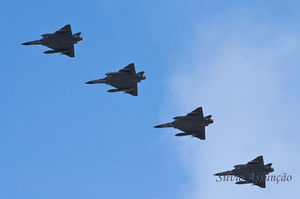 Brazilian Air Force Mirage 2000 formation. |
|
| Active | 1941–Present |
| Country | |
| Branch | Air Force |
| Size | 73,764 active personnel[1] 773 aircraft |
| Part of | Ministry of Defence |
| Command Headquarters | Brasília/DF |
| Patron | Alberto Santos Dumont[2]
Eduardo Gomes[3] |
| Motto | Wings that protect the country |
| March | "Hino dos Aviadores" |
| Anniversaries | May 22 (anniversary) April 22 (fighter day) |
| Engagements | World War II |
| Commanders | |
| Commander-in-Chief | President Luiz Inácio Lula da Silva |
| Commander | Lieutenant-Brigadier Juniti Saito |
| Insignia | |
  |
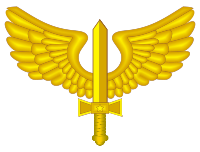 |
| Aircraft flown | |
| Attack | AMX, Super Tucano, AT-26 Xavante, Mi-35M |
| Bomber | AMX |
| Electronic warfare |
Embraer R-99 |
| Fighter | Northrop F-5E/F Tiger II |
| Interceptor | Dassault Mirage 2000 |
| Patrol | Lockheed P-3 Orion, Bandeirulha C-95 |
| Reconnaissance | Super Tucano, R-35 |
| Trainer | Tucano, AT-26 Xavante |
| Transport | C-130, C-295, Super Puma, 707, UH-1H, EMB-190, UH-60L |
The Brazilian Air Force (Portuguese: Força Aérea Brasileira, FAB) is the air branch of the Brazilian Armed Forces and one of the three national uniformed services. The FAB was formed when the Army and Navy air branch were merged into a single military force initially called "National Air Forces". Both air branches transferred their equipment, installations and personnel to the new force.
The FAB is the largest air force in South America, with about 700 manned aircraft in service, and 73,000 personnel on active duty.[4] An additional 7,655 civilian personnel are employed.[5]
Contents |
History
Creation
The establishment of the Royal Air Force in 1918 and the creation of the Italian Air Force (Regia Aeronautica) and the French Air Force during the 1920s drove the idea of uniting Brazilian air power under the same organization. Together with these events the Brazilian strategists were also influenced by the theories of Giulio Douhet, Billy Mitchell and Hugh Montague Trenchard.
The first public manifest[6] to create an integrated military air service came up in 1928 when an army Major called Lysias Rodrigues wrote an article called "An urgent need: The Ministry of the Air" ("Uma premente necessidade: o Ministério do Ar"). Two years later the French Military Mission, working for the Brazilian Army, made the first steps to organize a national air arm. The idea got more support when a group of Brazilian airmen came from Italy in 1934 and explained the advantages of having a military aviation unified. Also, the Spanish Revolution and the first movements of World War II at the end of the thirties showed the importance of Air power for military strategies.
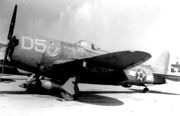
One of the main supporters of the plan to create an independent air arm was the then-president Getúlio Vargas. He organized a study group early in 1940 and the whole structure of the Ministry of Aeronautics (Ministério da Aeronáutica) was established the end of that year. This new governmental agency was responsible for the all aspects of the civil and military aviation including infrastructure, regulation and organization.[7]
Formally, the Ministry of Aeronautics was founded on January 20, 1941 and so its military branch called "National Air Forces", changed to "Brazilian Air Force" (Força Aérea Brasileira - FAB) on May, 22. The Army ("Aviação Militar") and Navy ("Aviação Naval") air branches were extinguished and all personnel, aircraft, installations and other related equipment were transferred to FAB.[7]
World War II
Equipped with American aircraft, mainly the P-47 Thunderbolt, the FAB saw action on the Italian front. The work of the pilots and support personnel was recognized by a Presidential Unit Citation issued on April 26, 1986—one of only three[8] non-US squadrons to receive such a citation.
Brazilian Air force contribution in the World War II:
- Executed Missions - 445
- Offensive - 2,546
- Defensive - 4
- Flight hours in the war - 5,465
- Total flight hours - 6,144
- Launched Bombs - 4,442
- Caliber ammunition 0.50 - 1,180,200
- Rockets - 850
- Gasoline consumed - 4,058,651[9]
| Targets | Destroyed | Damaged |
| Aircraft | 2 | 9 |
| Locomotives | 13 | 92 |
| vehicles | 1,304 | 686 |
| Wagons and tank cars | 250 | 835 |
| Armored Cars | 8 | 13 |
| Bridges, railroad and highways | 25 | 51 |
| Cuts railroad and location | 412 | |
| Buildings occupied | 144 | 94 |
| Enemy camps | 1 | 4 |
| Artillery positions | 85 | 15 |
| Enemy Accommodation | 3 | 8 |
| Factory | 6 | 5 |
| Enemy facilities | 125 | 54 |
| Electric Plants | 5 | 4 |
| Fuel and ammunition deposits | 31 | 15 |
| Oil Distillery | 3 | 2 |
| Radar stations | 2 | |
| Boats | 19 | 1 |
| Ship | 1 |
Post World War II
After the war, the FAB began flying the British Gloster Meteor jet fighter. The jets were purchased from the British for 15,000 tons of crude cotton, as Brazil had no foreign currency reserves to spare. The jet was operated by the FAB until the mid-1960s, when it was replaced by the F-80C and TF-33A, which were later replaced by the F-5 and Mirage III jets.
Cold War
During the Cold War, the Brazilian Republic was aligned with the United States and NATO. This meant that the F-5 could be bought cheaply from the United States, who called this jet the "Freedom Fighter". Many other countries, such as Mexico, also benefited from this policy.
The Embraer (Empresa Brasileira de Aeronáutica, Brazilian Aeronautic Co.) has its origins as an enterprise directly managed and sponsored by the FAB. Working with Italian corporations, it developed the new AMX attack aircraft (known locally as A-1) which makes up the backbone of the FAB's attack force. The successful Tucano T-27 trainer and the new light attack aircraft "A-29," are also Embraer aircraft used extensively by the FAB.
Present
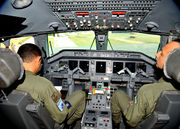
In the early 2000s, with renewed economic stability, the FAB underwent an extensive renewal of its inventory through several acquisition programs, the most ambitious of which was the acquisition of 36 new front-line interceptor aircraft to replace its aging Mirage III. Known as F-X Project the program was postponed once again in 2005. The competitors were the French Dassault Rafale, the Swedish SAAB-BAE Gripen, and the American F/A-18 Super Hornet.
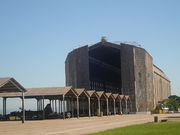
On July 15, 2005 one agreement was set with the French government for the transfer of twelve Dassault Mirage 2000s (ten "C" and two "B" versions) second-hand ex-Armée de L'Air. Known as F-2000s in Brazil, the first two aircraft arrived at Anápolis Air Base on September 4, 2006.
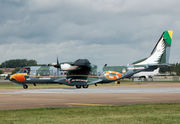
On November 4, 2007 the F-X Project underwent a small change. Now known as Project F-X2 and with a bigger budget, the competitors for acquisition were the Eurofighter Typhoon, Sukhoi Su-35, Saab Gripen, Dassault Rafale, Boeing F/A-18E/F Super Hornet and, although information on Lockheed Martin's F-35 Lightning II was requested, Lockheed Martin presented an F-16 Fighting Falcon variant (designated F-16BR).[12] In October 2008, FAB released a shortlist of 3 aircraft: SAAB Gripen NG, Dassault Rafale and Boeing F/A-18E/F Super Hornet. In February 2009, the three companies provided their final bids.[13] In September 2009, following a surprise French visit to Brazil, Brazilian President Luiz Inácio Lula da Silva and Nicolas Sarkozy, from France, made a new military cooperation agreement. Lula, on an interview at TV5 Monde, said french Rafale is a step forward, since technology transfer would be effective.[14]
On September 7, 2009, Brazilian Independence Day, it was announced Brazil would negotiate 36 Dassault Rafale.[15] But the Defence Minister did not confirmed if it is the final decision.
On January 5 2010, it was reported in the media that the final evaluation report by the Brazilian Air Force placed the SAAB Gripen NG ahead of the other contenders. The decisive factor was apparently the overall cost of the new fighters, both in terms of unit cost, and operating and maintenance costs.[16] Rafale reported not even be second choice.[17]
Other programs, however, were successfully completed and included the following (as of May 2007):
- ALX (Light Attack Aircraft) Program - 99 Super Tucano aircraft. Being delivered.
- F-5M Program - Upgrade of Northrop F-5 to F-5EM standard. Include new radar, avionics and weapons systems. Being delivered.
- CL-X (Medium Transport Aircraft) - Replacement of DHC-5 Buffalo aircraft. 12 CASA C-295 aircraft acquired. Being delivered.
- P-X (Maritime Patrol) Program- Replacement of EMB-111A aircraft for modernized P-3 airframes with EADS avionics. Being implemented.
- Interim Mirage 2000C purchase. Delivered as June 2008.
- Acquisition of presidential transport aircraft, known as FAB 001. An Airbus ACJ was bought and delivered in 2005.
- Acquisition of 18 'Super Cougar'. VIP Transport and Military transport should be their primary function.
- A-1M Program - Upgrade of the AMX International AMX in use in FAB. Include a new radar, HMD, new RWR, new FLIR, a new laser target designator, datalink, 3 MFCD and much more. Embraer announced that Elbit is going to develop the avionics to the A-1 through Aeroeletronica, Brazilian subsidiary of Elbit. The program is delayed and should be finished until 2014.
- AT-27M and C-95M Programs - Upgrade of 60 AT-27 and 80 C-95. Few details published.
Pending programs:
- CT-X (Light Transport Aircraft) Program- To replace the C-95 Bandeirante. CASA C-212-400 Aviocar is likely choice.
- F-X2 Program, However September 7, 2009, was announced that the Brazilian Government would buy the Dassault Rafale, however CIESP released an open letter that "the French fighter, if chosen, represents a defeat".[18]
2008 order:
- 12 Mi-35M helicopters
- 18 EC-725BR 'Super Cougar' helicopters
The Brazilian air force hosted the joint exercise Cruzex.
Command structure
The Brazilian Air Force is the aerospace branch of the Brazilian armed forces and is managed by the "Aeronautics Command" (Comando da Aeronáutica - COMAer). The COMAer was created in 1999[19] and replaced the Ministry of Aeronautics. Now, the COMAer is one of the three armed forces assigned to the Ministry of Defense (Ministério da Defesa).
The COMAer is led by the "Aeronautics Commander" (Comandante da Aeronáutica). Unlike USAF, the Commander is a "Tenente-Brigadeiro-do-Ar" (the most senior rank used in the Air Force, which is essentially the same as a USAF four-star general). He is nominated by the President and reports directly to the Minister of Defense.
COMAer comprises six major components, four "General Commands" (Comandos-Gerais) and two "Departaments" (Departamentos). The "General Command of Air Operations" (Comando-Geral de Operações Aéreas - COMGAR), with headquarters in Brasilia, supervises most of the flying operations. As the main flying element, COMGAR administers several sub-formations in the form of four "Air Forces" (Forças Aéreas) and seven "Regional Air Commands" (Comandos Aéreos Regionais - COMAR).
Besides COMGAR, other major parallel organizations, which also report directly to the COMAer, are the "General Command of Support" (Comando-Geral de Apoio - COMGAP), "General Command of Personnel" (Comando-Geral de Pessoal - COMGEP), "General Command of Aerospatial Technology" (Comando-Geral de Tecnologia Aeroespacial - CTA), "Aeronautics Departament of Teaching" (Departamento de Ensino da Aeronáutica - DEPENS), "Departament of Civil Aviation" (Departamento de Aviação Civil - DAC) and "Departament of Airspace Control" (Departamento de Controle do Espaço Aéreo - DECEA).
Air units organization
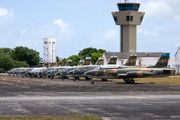
At unit levels, "Groups" (Grupos) usually consist of one to sixteen consecutively-numbered "Squadrons" (Esquadrões), each with varying numbers of aircraft, usually from six to 12. Smaller formations are known as "Flights" (Esquadrilhas). According to its tasks, a group has one of the following designations:
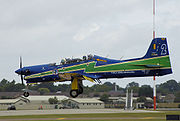
- Air Defense Group: Grupo de Defesa Aérea (GDA): Air defense fighters. (Fighter Jets)
- Transport Group: Grupo de Transporte (GT): Transport, Flight refueling
- Aviation Group: Grupo de Aviação (GAv): Fighter, attack, reconnaissance, SAR, rotary wing
- Fighter Aviation Group: Grupo de Aviação de Caça (GAvCa); Fighter, attack planes
- Troop Transport Group: Grupo de Transporte de Tropas (GTT): Transports, troop carrying, parachutist drop
- Special Flight Inspection Group: Grupo Especial de Inspeção em Vôo (GEIV): Calibration
- Special Test Flights Group: Grupo Especial de Ensaios de Vôo (GEEV): Test flights
- Special Transport Group: Grupo de Transporte Especial (GTE): VIP transport
Common used designations for squadrons are:
- Air Transport Squadron: Esquadrão de Transporte Aéreo (ETA)
- Air Training Squadron: Esquadrão de Instrução Aérea (EIA)
- Demonstration flying team: Esquadrão de Demonstração Aérea (EDA) (also called "Esquadrilha da Fumaça")
The air units are organized as follows:
| COMGAR sub-formation | Air unit | Aircraft type | Air base |
|---|---|---|---|
| I FAe | 1º/5º GAv | C-95 | Natal |
| 2º/5º GAv | A-29B | Natal | |
| 1º/11º GAv | UH-50 | Natal | |
| II FAe | 1º/7º GAv | P-95B,P-3AM | Salvador |
| 2º/7º GAv | P-95B | Florianópolis | |
| 3º/7º GAv | P-95A | Belém | |
| 4º/7º GAv | P-95A | Santa Cruz | |
| 1º/8º GAv | UH-1H | Belém | |
| 2º/8º GAv | AH-2(MI-35M) | Porto Velho | |
| 3º/8º GAv | H-34,UH-55 | Afonsos | |
| 5º/8º GAv | UH-1H | Santa Maria | |
| 7º/8º GAv | H-60 | Manaus | |
| 2º/10º GAv | UH-1H,SC-95B,SC105A | Campo Grande | |
| III FAe | 1º/1º GAvCa | F-5EM,AT-27 | Santa Cruz |
| 2º/1º GAvCa | F-5EM,AT-27 | Santa Cruz | |
| 1º GDA | F-2000,AT-27 | Anápolis | |
| 1º/3º GAv | AT-27,A-29,A-29B | Boa Vista | |
| 2º/3º GAv | AT-27,A-29,A-29B | Porto Velho | |
| 3º/3º GAv | AT-27,A-29,A-29B | Campo Grande | |
| 1º/4º GAv | AT-26,AT-26A,F5EM,F5FM | Fortaleza (to Manaus) | |
| 1º/6º GAv | R-35A,R-95 | Recife | |
| 2º/6º GAv | R-99A/B,C-98 | Anápolis | |
| 1º/10º GAv | A-1,A-1B | Santa Maria | |
| 3º/10º GAv | RA-1,RA-1B | Santa Maria | |
| 1º/14º GAv | F-5EM,F-5FM,AT-27 | Canoas | |
| 1º/16º GAv | A-1,A-1B | Santa Cruz | |
| V FAe | 1º GTT | C-130H | Afonsos |
| 1º/1º GT | C-130H/KC-130H | Galeão | |
| 1º/2º GAv | C-99 | Galeão | |
| 2º/2º GAv | KC-137 | Galeão | |
| 1º/9º GAv | C-105A | Manaus | |
| 1º/15º GAv | C-105A | Campo Grande | |
| I COMAR | 1º ETA | C-95B,C-98,C-97 | Belém |
| II COMAR | 2º ETA | C-95,C-97 | Recife |
| III COMAR | 3º ETA | C-95B,C-97 | Galeão |
| IV COMAR | 4º ETA | C-95A,C-97 | São Paulo |
| V COMAR | 5º ETA | C-95A,C-97 | Canoas |
| VI COMAR | 6º ETA | C-95c, VU-9,VC-97 | Brasília |
| VII COMAR | 7º ETA | C-97,C-98 | Manaus |
Other air units are:
| Major component | Air unit | Aircraft type | Air base |
|---|---|---|---|
| DECEA | GEIV | EC-95B/C,EU-93A | Santos Dumont Airport |
| CTA | GEEV | A-1,XU-93,T-27,CH-55 | São José dos Campos |
| DEPENS | 1º EIA | T-27 | Pirassununga |
| DEPENS | 2º EIA | T-25A/C | Pirassununga |
| DEPENS | Clube de Vôo a Vela | U-19,Z-15,Z-16,TZ-13 | Pirassununga |
| DEPENS | Support | C-95A,UH-50,U-7 | Pirassununga |
| Reporting direct to Air Force cabinet | GTE | VC-1A,VC-96,VC-99C,VH-34,VH-55,VH-35 | Brasília |
| Reporting direct to Air Force cabinet | EDA | T-27 | Pirassununga |
The Air Force Bases of the Brazilian Air Force are:
| Location | State | ICAO | IATA | Airport name |
| Anápolis | Goiás | SBAN | Anápolis Air Force Base | |
| Belém | Pará | SBBE | Belém Air Force Base | |
| Boa Vista | Roraima | SBBV | Boa Vista Air Force Base | |
| Brasília | Federal District | SBBR | Brasília Air Force Base | |
| Campo Grande | Mato Grosso do Sul | SBCG | Campo Grande Air Force Base | |
| Canoas | Rio Grande do Sul | SBCO | Canoas Air Force Base | |
| Florianópolis | Santa Catarina | SBFL | Florianópolis Air Force Base | |
| Fortaleza | Ceará | SBFZ | Fortaleza Air Force Base | |
| Guarulhos | São Paulo | SBGR | GRU | São Paulo Air Force Base |
| Manaus | Amazonas | SBMN | PLL | Manaus Air Force Base |
| Natal | Rio Grande do Norte | SBNT | Natal Air Force Base | |
| Porto Velho | Rondônia | SBPV | Porto Velho Air Force Base | |
| Recife | Pernambuco | SBRF | Recife Air Force Base | |
| Rio de Janeiro | Rio de Janeiro | SBGL | GIG | Galeão Air Force Base |
| Rio de Janeiro | Rio de Janeiro | SBSC | SNZ | Santa Cruz Air Force Base |
| Rio de Janeiro | Rio de Janeiro | SBAF | Afonsos Air Force Base | |
| Salvador | Bahia | SBSV | Salvador Air Force Base | |
| Santa Maria | Rio Grande do Sul | SBSM | Santa Maria Air Force Base | |
| Santos | São Paulo | SBST | SSZ | Santos Air Force Base |
| Serra do Cachimbo | Pará | SBCC | Brigadeir Velloso Test Site |
Operations
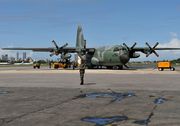
A recent operation of the FAB was the bombing of illegal landing sites in the Amazon Forest, used by drug dealers to transport drugs into and out of Brazil (see SIVAM). The operation also had support from the Brazilian Army and Brazilian Federal Police with many drug dealers being arrested as a result. The AMX Bomber/Fighter was the primary plane used.
The FAB is currently working on the United Nations Stabilization Mission in Haiti (MINUSTAH) supporting the United Nations force (a joint Brazilian, Uruguayan, Chilean and Argentine force) deployed there.
Also, the FAB is working on the Search & Rescue mission of Air France flight AF447. The Brazilian Air Force has started a search and rescue from the Brazilian archipelago of Fernando de Noronha, highlighting eight planes to search a stretch bounded by the coastal cities of Recife, Natal and the archipelago of Fernando de Noronha.
SIVAM
FAB is responsible for the aerospace vigilance and defence on program Sistema de Vigilância da Amazônia (Amazon Surveillance System).
Aircraft inventory
| Mirage 2000 | F-5EM | AMX | Total | |
| Quantity | 12 | 57 | 55 | 124 |
The FAB operates some 750+ aircraft, including 124 main combat aircraft.
Aerospace vehicles
| Name | Origin | Type | Model | Quantity[21] | Notes | Picture |
|---|---|---|---|---|---|---|
| Combat Aircraft | ||||||
| AMX International AMX | attack/reconnaissance lead-in trainer |
A-1 A-1B |
42 10 |
Modernization to 43 A-1M standard started by Embraer and Elbit. To be withdraw until 2025. |
 |
|
| Dassault Mirage 2000 | interceptor lead-in trainer |
F-2000C F-2000B |
10 2 |
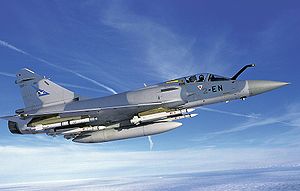 |
||
| Northrop F-5E/F Tiger II | fighter lead in trainer |
F-5E/F - F-5EM/FM | 10 47 |
Modernization to F-5M standard in progress. To be withdrawn from service by 2015 (Replacement by winner FX-2 program) |
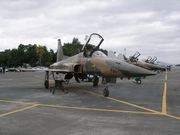 |
|
| Trainer/Light Attack Aircraft | ||||||
| Atlas Impala | attack/trainer | AT-26A | 11 | Second hand from South Africa. To be withdrawn until 2011. |
 |
|
| Embraer EMB 312 Tucano | trainer/light attack | AT/T-27 | 109 | 60 to be upgraded for AT-27M |
 |
|
| Embraer EMB 314 Super Tucano | attack/advanced trainer | A-29/29B | 83 | Total of 99 to be delivered |
|
|
| Embraer EMB 326GB Xavante | trainer/attack | AT-26 | 20 | Being withdrawn between 2010-2012 |
 |
|
| Transport Aircraft | ||||||
| Airbus A319 | VIP Transport | VC-1A | 1 |
 |
||
| Boeing 737 | VIP transport | VC-96 (737-200) | 2 |
 |
||
| Beechcraft King Air 90 | staff transport | Beech 90 | 1 |
|
||
| Boeing KC-137 Stratoliner | tanker/transport | KC-137 (707-320C) | 4 |
_Perth_Internatinal_Airport_Australia.jpg) |
||
| British Aerospace BAe 125-400 | Flight test | XU-93 | 1 | The last VU-93 version was phased out in jan/2007. Only one (FAB 2123) still flying with GEEV |
 |
|
| EADS/CASA C-295 | transport SAR | C-105A | 12(+8) | Intend to order another 8 in 2009. |
 |
|
| Embraer EMB 110 Bandeirante | utility transport transport aerial survey maritime patrol |
TOTAL C-95/P-95/R-95 C-95/A/B/EC-95/SC-95B C-95C (EMB 110P1K) RC-95 (EMB 110B) P-95A/B (EMB-111) |
88 59 5 5 19 |
7º ETA retired C-95. 54 to be upgraded for C-95M |
|
|
| Embraer EMB 120 Brasília | transport VIP transport VIP transport |
TOTAL C-97 C-97 (EMB 120) VC-97 (EMB 120ER) VC-97 (EMB 120RT) |
17 9 3 5 |
 |
||
| Embraer EMB 121 Xingu | VIP transport | VU-9 | 8 |
|
||
| Embraer ERJ 135BJ Legacy | VIP transport | VC-99C | 4 |
 |
||
| Embraer ERJ 145 family | transport/VIP transport | C-99 (ERJ-145ER) | 7 |
 |
||
| Embraer 190 | VIP transport | VC-2 | 2 |
|
||
| Learjet 35 | VIP transport special mission |
VC-35 R-35A |
9 3 |
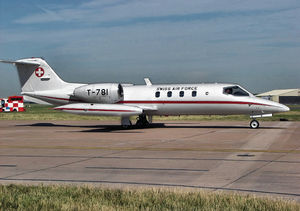 |
||
| Learjet 55 | VIP transport | VU-55C | 1 | |||
| Lockheed C-130 Hercules | tactical transport tanker |
C-130E/H KC-130H |
21 2 |
Some can be configured to KC standard |
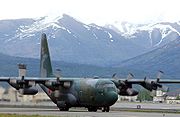 |
|
| Helicopters | ||||||
| Bell UH-1 Iroquois | utility helicopter | UH-1H | 33 | To be withdraw until 2012. Replaced for EC-725BR and UH-60 |
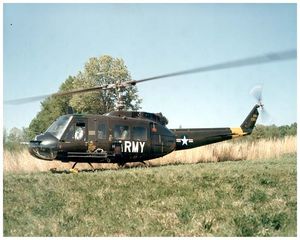 |
|
| Bell 206 JetRanger | utility helicopter | H-4B (206B) | 3 |
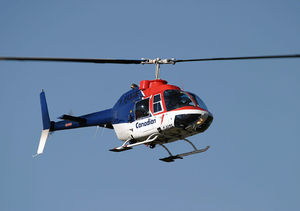 |
||
| UH-60 Black Hawk | combat search and rescue | H-60L | 10(+5)[22] | 10 more ordered, 04 in June 2009 and other 06 ordered in September 2009. |
|
|
| Eurocopter AS-332 Cougar | transport helicopter VIP helicopter |
CH-34 (AS-332M) VH-34 |
6 2 |
 |
||
| Eurocopter EC 135 | VIP helicopter | VH-35 (EC-135T2i) | 2 |
 |
||
| Helibras HB-350B | utility helicopter | H-50 | 25 |
 |
||
| Helibras HB-355 | utility helicopter | H-55 | 3 |
 |
||
| Mi-35M | Attack helicopter | AH-2 Sabre | 3(+9) | Ordered in December 2008. Deliveries start in 2009 and finish in 2010.[23] |
 |
|
| utility | ||||||
| Embraer EMB 210R Ipanema | utility | U-19 | 4 | |||
| Embraer EMB 810 Seneca II/III | utility | U-7/7A (EMB 810C) | 9 |
 |
||
| Piper PA-32 Cherokee | utility | 1 |
 |
|||
| Cessna 208 Caravan | utility | C-98 (208A) C-98B (208B) |
8 10 |
1 lost in accident |
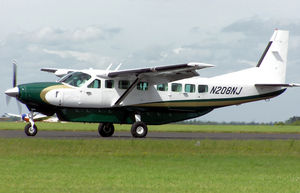 |
|
| Training Glider | ||||||
| Glasflügel H-201 | Training glider | Z-15 | 1 |
 |
||
| IPAE Quero-Quero | Training glider to be retired in 2011 | Z-16 | 5 | 1 lost in hangar accident | ||
| LET Blaník L-13/L-23/L-33 Blaník/Super Blaník/Solo | Training glider | TZ-13 (L-13) TZ-13 (L-23) TZ-13 (L-33) |
3 4 2 |
|
||
| Neiva T-25 Universal | basic trainer | T-25A/B/C | 68 | |||
| Schleicher ASW 20 | Training glider | Z-20 | 1 |
|
||
| Reconnaissance Aircraft | ||||||
| Lockheed P-3 Orion | maritime patrol | P-3M/BR | 1[22] | 8 more on order |
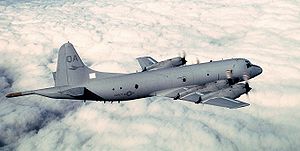 |
|
| Embraer R-99 | AEW | R 99 | 5 E-99s 3 R-99s |
 |
||
| Liaison | ||||||
| Neiva Regente | liaison | U-42 | 21 | Being withdrawn | ||
- Future aircraft
| Name | Origin | Type | Model | Quantity | Notes | Picture |
|---|---|---|---|---|---|---|
| Eurocopter EC 725 | Transport helicopter | EC 725 | 18 (8 C-SAR+8 Transport Version+2 VIP) | The Brazilian Government has announced that an Helibrás factory in Itajubá, Minas Gerais, will produce, initially, 50 units of EC 725. First units will be operational in 2010[24]. |
 |
|
| Embraer KC-390 | Transport aircraft | KC-390 | 3 + 22 | 28 KC-390 on order in 22/07/2010. more.[25] |
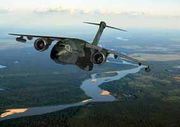 |
|
| P-3 Orion | Maritime patrol aircraft | P-3AM | 9 | 8+1(for training)+3 (for surplus)P-3AM(Upgraded). Integrated with the CASA FITS (Fully Integrated Tactical System), it will be used in Anti-submarine warfare.[26] |
 |
|
| Unknown | Tanker aircraft | 2 | Acquisition of new aerial refueling aircraft (2013) |
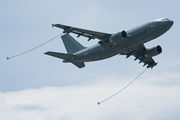 |
Weapons
Missiles, bombs and rockets
| Type | Product | On order | Origin | QTD |
|---|---|---|---|---|
| Air to air missile | MAA-1B "Piranha B" | This new version of the Piranha, fits as a 4th generation missile with "off boresigh", about 90°, and an greater range of 50% | ||
| Anti-ship missile | MAN-1 | It will be an anti-ship missile with a 60–80 km range. | ||
| Air to air missile | A-Darter | 5° Generation Air to Air missile | ||
| Air to air missile | Mectron MAA-1 Piranha | Short range Air to Air missile | ||
| Anti-radiation missile | MAR-1 | Brazilian anti-radiation missile (ARM) | ||
| Air to air missile | Derby | Beyond-visual-range (BVR) air-to-air missile | ||
| Air to air missile | Python -3 and -4 | Short range air-to-air missile | ||
| Air to air missile | R550 Magic | Short-range | ||
| Air to air missile | Super 530 | Short-range | ||
| Cluster Bomb | BLG-252 | Bomb | ||
| Incendiary bomb | BINC-300 | Bomb | ||
| Guided bombs | Elbit Lizard | Laser Guided Bomb | ||
| Guided bombs | SMKB-82/83 | GPS Guided Bomb (known like AKAUAN) | ||
| Guided bombs | Mark 83 bomb | GPS Guided Bomb (known like AKAUAN) | ||
| Guided bombs | Mark 82 bomb | GPS Guided Bomb (known like AKAUAN) | ||
| Rockets | Avibras Skyfire 70 | Rocket Air-to-Surface/Surface-to-Air | ||
| Rockets | SBAT-70 | Rocket Air-to-Surface/Surface-to-Air |
Pistols and rifles
| Platform | Origin | Type | In service | Notes |
|---|---|---|---|---|
| HK33 | Rifle | |||
| SG 550 | Rifle | |||
| Taurus MT-12 | Submachinegun | M-972 | ||
| Taurus PT-92 | Pistol | M-975 |
Radar
| Platform | Origin | Type | In service | Notes |
|---|---|---|---|---|
| M-60 | Radar | 04 | in test Purchased pilot lot with range of 60 km to 75 km |
Air Defence Systems
| Platform | Origin | Type | In service | Notes |
|---|---|---|---|---|
| 9K38 Igla | SAM | 50 |
The Brazilian Army also operates rotary-wing aircraft, while the Brazilian Navy operates both fixed- and rotary-wing aircraft.
See also
- Aerial Demonstration Squadron
- Brazilian Naval Aviation
- Brazilian Navy
- Brazilian Army
- Military ranks of Brazil
- Military history of Brazil
- Brazil and weapons of mass destruction
- Alberto M. Torres
Notes
- ↑ FAB em números Brazilian Air Force. Retrieved on 2009-02-01. (Portuguese)
- ↑ Aeronautical -
- ↑ Brazilian Air Force -
- ↑ http://revistaepoca.globo.com/Revista/Epoca/1,,EMI14440-15273,00.html
- ↑ Sala de imprensa - FAB em números
- ↑ INCAER, 1991 - História Geral da Aeronáutica vol. 3, Capítulo 1
- ↑ 7.0 7.1 http://adluna.sites.uol.com.br/200/228.htm
- ↑ DA CUNHA, R. D. . Os Esquadrões da Fita Azul. Revista Força Aérea, Rio de Janeiro, p. 110 - 113, 01 jun. 1999.
- ↑ 9.0 9.1 http://www.incaer.aer.mil.br/opusculo_fab_seg_guerra.pdf
- ↑ http://www.2guerra.com.br/sgm/index.php?option=com_content&task=view&id=124&Itemid=34
- ↑ http://pbrasil.wordpress.com/2009/08/23/
- ↑ [1] Aviation Week - Brazil Offered F-16s, Not F-35s
- ↑ "Brazilian fighter programme ready to fly", Flight International, 3 April 2009.
- ↑ "Negociações para compra de caça francês estão ‘muito avançadas’, diz Lula"
- ↑ "Brasil confirma acordo para compra aviões militares da França"
- ↑ "FAB prefere caça sueco a francês"
- ↑ "Gripen favorit i Brasilien"
- ↑ Brazil's F-X2 contest prompts further dispute
- ↑ Lei complementar no97 de 9 de junho de 1999
- ↑ http://revistaepoca.globo.com/Revista/Epoca/0,,EMI14439-15273-2,00-UMA+NOVA+AGENDA+MILITAR.html
- ↑ Aviation Week & Space Technology 2009, 26 JAN 2009 240. Web.28 Aug 2009. <http://www.aviationweek.com/aw/sourcebook/content.jsp?channelName=pro&story=xml/sourcebook_xml/2009/01/26/AW_01_26_2009_p0240-112924-158.xml&headline=World%20Military%20Aircraft%20Inventory%20-%20United+States>.
- ↑ 22.0 22.1 Brazilian military aviation OrBat
- ↑ http://en.rian.ru/russia/20090406/120935753.html
- ↑ http://www.agenciabrasil.gov.br/noticias/2008/09/08/materia.2008-09-08.2525261585/view
- ↑ http://www.flightglobal.com/articles/2009/04/14/325113/brazilian-air-force-signs-deal-launching-embraer-kc-390-tanker-transport.html
- ↑ http://www.brazil.eads.net/1024/pt/press/press/20090429_airbus_military_p-3.html
External links
- Brazilian Air Force website (Portuguese)
- Brazilian Air Force page at Scramble
- History of Brazilian Air Force in World War II (Portuguese)
- History of the Brazilian Air Force
- Milavia - Brazilian Air Force
- Military orders and medals from Brazil (in Portuguese)
|
|||||
|
||||||||||||||